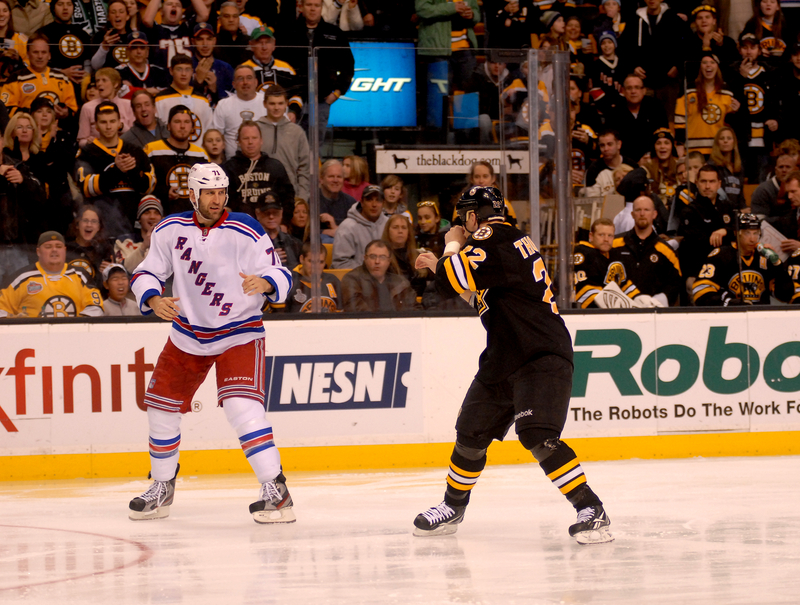Last updated on November 3rd, 2023 at 05:31 pm
The most common reason for an ice hockey fight pertains to retaliation against your opponent. Retaliation can mean a handful of things, but most relate to another player striking your teammate on the ice. Other retaliations could pertain to an incident earlier in the season that did not receive closure. For example, your star player may have gotten hurt from a team in that season, so you want to make a statement the next time you play via a fight.
Another reason for brawls is a way to rally your team to play better on the ice. If your star player sustains an injury during a game or your organization is losing by a lot, you may want to fight. Winning a fight can improve the morale of the team, and can make the team play better due to the new motivation.
Competitive games usually bring the most intense pressure on any hockey game. For example, you can expect plenty of cheap shots when the Boston Bruins and Montreal Canadians are playing each other on the ice. Due to the rivalry of these two franchises, fans, coaches, and players can be ready for physical altercations. Here is a guide to all NHL rivalries if you are curious.
Finally, intimidation is another reason to fight in hockey. Any chance to make the other team nervous when crossing the blue line towards a defenseman is an advantage. The fear of getting hit, or getting into a fight, can be an excellent advantage for any team.
What are the Rules for Fighting in Ice Hockey?
Fighting, formerly know as Fisticuffs in 1922 as Rule 46, was the official name for fighting in the National Hockey League. Unlike a traditional brawl that you might see in the MLB, hockey fights are an art form since everyone is on skates. However, there are unwritten rules for fighting that NHL players need to remember, which I list below.
Most fights begin with two players chirping back and forth to each other, agreeing to fight, throwing off the gloves, and getting into a battle. Once the fight begins, the referees pause the game to allow the players to compete. Generally, both players start the altercation by grabbing on each other for a few moments to gather balance and then begin punching. After throwing a few punches, the refs start breaking up the fight if one person is losing the match.
Why Do Hockey Players Take Their Gloves off to Fight?
Hockey fans may wonder why players take their gloves off right before a fight. The primary reason for NHL players taking the gloves off is a sign of respect that a battle is about to take place. If one player does not drop their gloves, players take that the code that the other side does not want to fight. If you decide to fight with your gloves on during an NHL game, you’ll receive a suspension from the league. Another note is that players can’t fight with their hockey sticks during a battle on the ice.
What is an Enforcer in Hockey?
An enforcer in hockey is the tough guy on the team who gets into fights. While an unofficial role in the league, you will see most teams have that one goon on their side who can respond to dirty plays on the ice. The enforcer typically stands up for their teammates by checking and or fighting the opposing teams after big hits. Most hockey games don’t carry more than one enforcer on their bench but will bring that player in throughout a hockey game in retaliation.
Is there a Penalty for Fighting in the NHL?
Fighting during hockey games sends you to the penalty box for five minutes. Each side has one player enter the penalty box since fighting takes place between two members, so there is no uneven amount of players on the ice. Even if you win or lose the fight, you still go to the penalty box for five minutes.
There are many different types of penalties in hockey during a game. The classification of penalties includes delayed, minor, and major during a hockey game. A major penalty is an NHL fight that takes place during a game.
Do Goalies Ever Get into Fights?
Goalie fights, while rare, can take place during an NHL game. Most goalie fights happen when the rest of the NHL players are fighting each other. Goalies don’t get sent to the penalty box for fighting, but instead, have a player on their team take that seat. The only way for a goalie to leave a game outside of an injury is by receiving an ejection. However, goalies use to sit in the penalty box during the 1941 and 1942 seasons after a fight.
Is Fighting Allowed in the NHL Playoffs?
Unlike the regular season where there are minor penalties for fighting, the postseason serves greater discipline. Any form of combat that occurs via the second time is subject to a player suspension for the next playoff game. With the fear of a game suspension taking place, many teams stay away from fighting during a playoff game or Stanley Cup final. Rule changes like an immediate suspension are a welcome sign to hockey fans who don’t want to see their star players hurt during a fight.
Why Do the Refs in NHL Not Stop Players When they Start Punching Each Other?

Since fighting is part of hockey, refs act as the referee, almost like you would see during a boxing match. Since both players are choosing to fight each other, the ref is there as a moderator. Until the right becomes out of hand, you will see the ref stand by during the actual fight.
Another reason why refs don’t break up fights is for hockey fans. Fighting in hockey makes hockey fans go crazy, so refs don’t want to ruin the moment between teams and fans. Unless it is during a playoff game or Stanley Cup match, refs usually let the players work out their differences via a fight.
Is the NHL Trying to Stop Fights?
According to the data at the start of the article, fighting per game is significantly down from ten years ago. Gary Bettman, the NHL commission, brings down fighting by updating the rule book with new penalties for starting fights. The two new punishments via NHL fights include the Instigator and Aggressor penalties.
The Instigator penalty includes one member who starts the fight on the ice. Beginning the battle first involves dropping the gloves early and or skating over to the opposing player to fight them. The instigator’s penalty includes being down one man for two minutes, a ten-minute misconduct penalty, and a five-minute major depending on the severity of the issue.
Aggressor penalties include someone who is trying to fight another hockey player who does not want to fight. An Aggressor includes someone who won a fistfight but continues to throw punches as the ref breaks up the fight. Including the standard five minute penalty in the penalty box, Aggressors can serve suspensions after the game. An aggressor penalty is reviewable by the league, so the severity of getting this penalty helps reduce the amount of fighting in the league.
Conclusion
Hockey is a more physical sport than the MLB and NBA, so expect fights to take place on a more frequent basis. Most fighting takes place due to retaliation via a cheap shot, but other fights are a way to motivate your team to play better. While fights per game are going down each season, you still see NHL fights take place during games. At this time, you won’t see the NHL trying to ban fighting between players.
Similar Posts
What is a Power Play in Hockey?
What Does Icing Mean in Hockey?
Greg Kristan, owner of The Stadium Reviews, LLC and TM Blast, LLC, brings his extensive experience visiting over half of the MLB ballparks, along with numerous MLS, NHL, NBA, and NFL venues, to provide in-depth coverage on the bag policy, food options, and parking. He has also been interviewed about his experiences on several sports podcasts.


